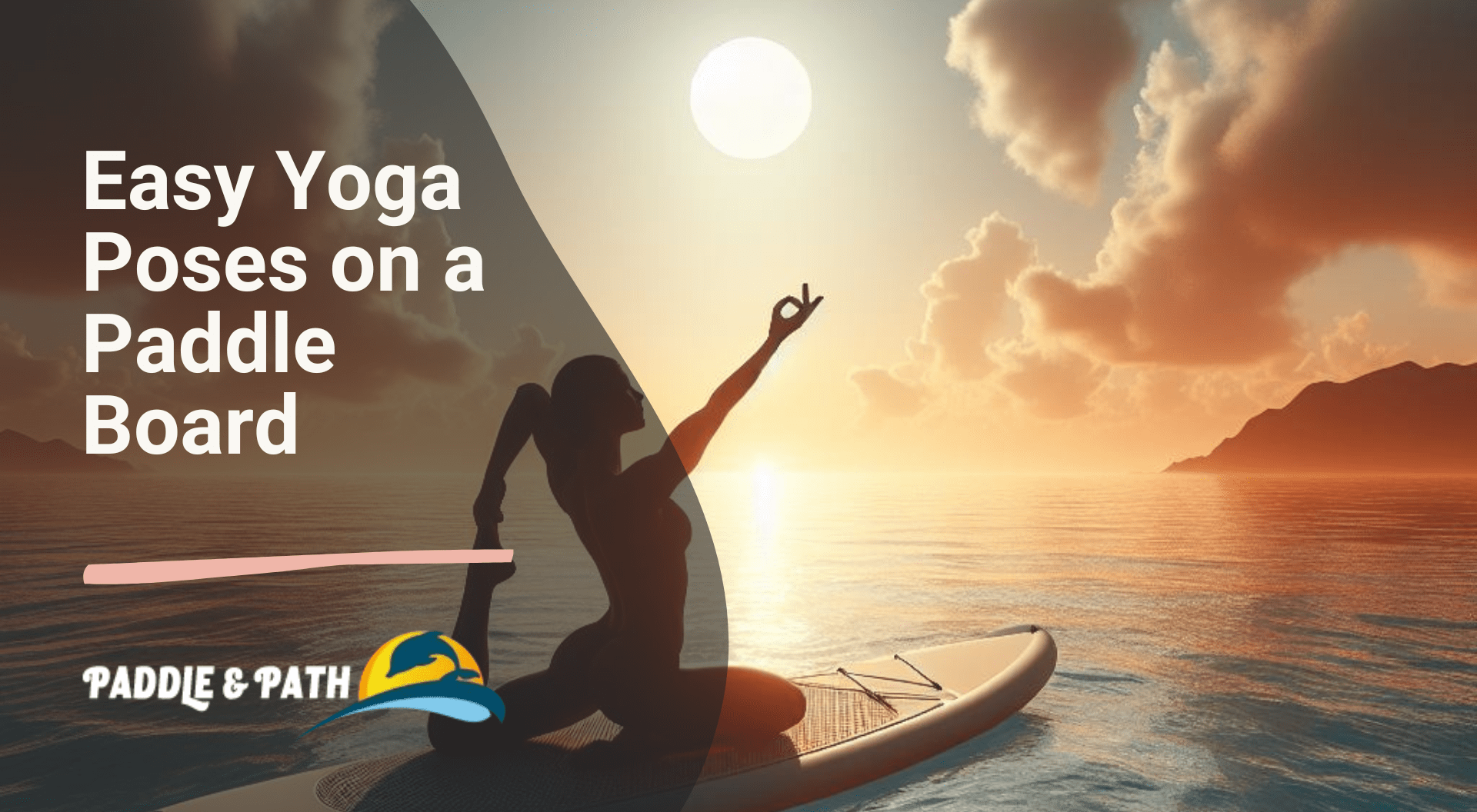Are you new to paddle board yoga and wondering what the easy yoga poses on paddle board that you can get started with? We will help you get started with simple and basic yoga poses that you can do on your paddle board. This unique practice combines the tranquility of yoga with the challenge of balancing on a paddle board.
We will explore the benefits of paddle board yoga, including improved balance, core strength, and mind-body connection. We will also discuss some basic yoga poses that are perfect for practicing on a paddle board, as well as offer tips for getting started and staying safe on the water.
So grab your board, and let’s dive in!
What Is Paddle Board Yoga?
Paddle board yoga is a unique form of yoga practice that combines traditional yoga poses with the challenge of balancing on a paddleboard in the serene setting of a body of water.
This innovative practice not only tests one’s physical strength and core stability but also enhances mental focus and mindfulness as practitioners navigate the gentle ripples of the water. The harmonious interaction with the natural elements adds a therapeutic dimension to the practice, promoting a sense of tranquility and connection with the surrounding environment.
The sound of water lapping against the board becomes a rhythmic soundtrack, aiding in relaxation and deepening the mind-body connection. You can really get into your Zen when you are outdoors in nature.
What Are The Easiest Yoga Poses to do on a Paddle Board?
Yoga in a studio is challenging especially if you are new to the practice. Once you have the hang of it and done it a few times, you will find them actually quite easy and relaxing to do. The first part of yoga to master is balance and this is definitely a requirement when on a paddle board.
Paddle boards to offer a good amount of stability, but you will need to engage your core to have full control. Here we have listed the easiest poses that you can do on a paddle board that will improve your balance and core. These poses are not that technical and there is no major transitioning in the poses.
Here are the easy to do yoga poses on a paddle board:
- Mountain Pose (Tadasana)
- Warrior II (Virabhadrasana II)
- Downward Facing Dog (Adho Mukha Svanasana)
- Tree Pose (Vrikshasana)
- Child’s Pose (Balasana)
These are straightforward and a great way to start your paddle yoga journey. Master these and you will enjoy them more.
What Are the Benefits of Paddle Yoga?
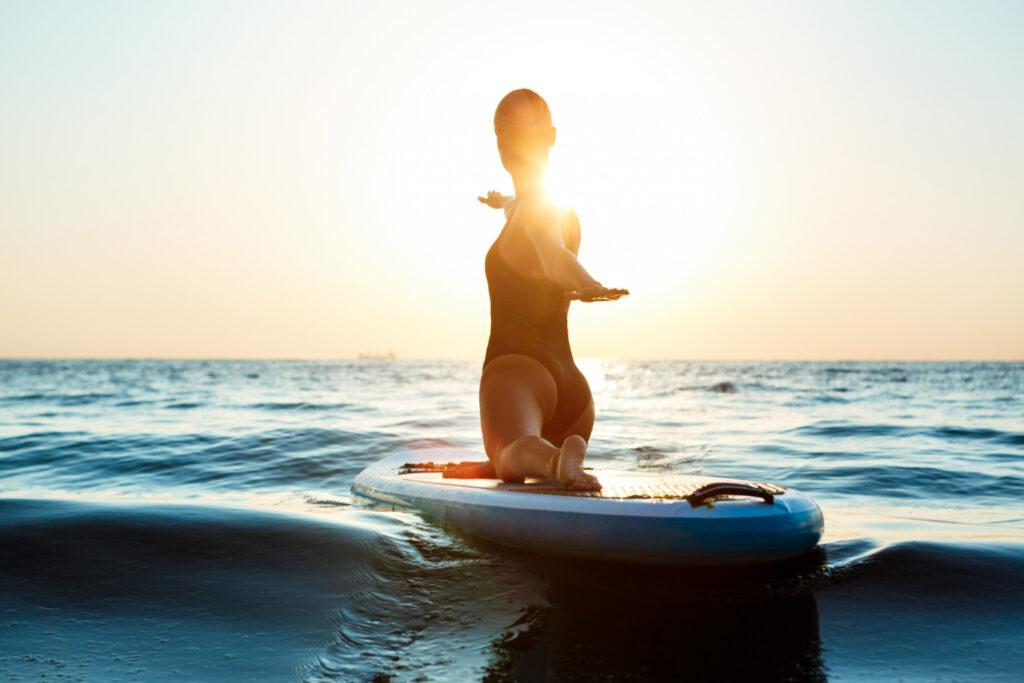
Engaging in paddle yoga offers a lot of benefits, including improved balance and core strength, enhanced mind-body connection, a unique workout experience, and a deep sense of relaxation amidst natural surroundings.
Practicing yoga on a paddle board forces you to engage your stabilizing muscles to balance on the water, leading to a stronger core and improved overall stability. Through the gentle movements and flowing sequences on the board, you can cultivate a deep sense of mindfulness and presence, allowing you to truly connect with nature and your inner self.
The serene environment of being out on the water adds a layer of tranquility to your practice, creating a sense of peace and harmony that is different that when you are in a traditional studio setting.
Improves Balance and Core Strength
Taking part in paddle board yoga sessions is an excellent way to enhance both balance and core strength through a series of standing and sitting yoga poses that challenge stability and promote muscle engagement.
The instability of the paddle board on water forces you to engage your core muscles continuously to maintain balance during various poses like the Warrior pose or the Downward-facing Dog. By incorporating these poses on an unstable surface, you activate deeper stabilizing muscles that are often underutilized in traditional yoga practices.
This enhanced engagement leads to improved overall strength and flexibility, making paddle yoga a uniquely effective way to boost one’s physical fitness.
Increases Mind-Body Connection
Practicing yoga on a paddle board creates a deeper mind-body connection as individuals synchronize their breath with movement, engage in meditation, and establish a profound connection with the natural elements surrounding them.
This unique fusion of yoga and paddle boarding allows practitioners to immerse themselves in a relaxing environment, enhancing mindfulness and promoting a sense of tranquility.
The gentle lapping of water beneath the board, the warmth of the sun on the skin, and the rustling of leaves nearby all contribute to a heightened state of awareness and presence. Through mindful movements and intentional breathing, participants can attune themselves to the rhythm of the water, fostering a harmonious relationship between body, mind, and nature.
Provides a Unique and Challenging Workout
Yoga on a paddle board offers a one-of-a-kind and invigorating workout experience that combines the fluidity of traditional yoga poses like Sun Salutation and various asanas with the dynamic challenge of balancing on water, creating a fusion known as Aqua Yoga.
This unique form of exercise not only engages your muscles to maintain stability and strength but also demands intense focus and concentration as you align your mind, body, and breath in the midst of rippling waters.
The serene backdrop of nature further enhances the mind-body connection, allowing practitioners to deepen their practice and experience a heightened sense of mindfulness.
The benefits of paddle board yoga extend beyond just physical fitness, promoting mental clarity, stress relief, and an overall sense of tranquility.
Helps to Relieve Stress and Promote Relaxation
Engaging in paddle yoga serves as a therapeutic outlet to alleviate stress, promote relaxation, immerse oneself in the tranquil beauty of nature, and enhance overall well-being through a calming and refreshing practice.
This unique form of yoga not only encourages a sense of mindfulness by requiring focus and balance on the water but also allows participants to connect deeply with the surrounding environment, fostering a sense of serenity.
Beyond the physical benefits of improving core strength and balance, practitioners often report feeling a profound sense of mental clarity and peace after a session.
The combination of the soothing water beneath and the vast sky above creates an immersive experience that rejuvenates both body and mind, making paddle yoga a holistic approach to health and wellness.
What Are the Basic Yoga Poses to Do on a Paddle Board?
When starting out with yoga on your paddle board, does require mastering a set of basic yoga poses tailored for beginners, focusing on enhancing strength, flexibility, and balance while adapting to the dynamic environment of the paddle board on water.
These fundamental poses aid in building a strong foundation for your practice while helping you develop body awareness and core stability. The Mountain Pose (Tadasana) teaches you to stand tall and grounded on the board, engaging your legs and core.
Moving into the Warrior Poses (Virabhadrasana I, II, III) challenges your strength and balance, enhancing your focus and stability. The Bridge Pose (Setu Bandhasana) targets your back and hip flexibility, crucial for paddle board stability, while the Boat Pose (Navasana) strengthens your core muscles for improved balance on the water.
Mountain Pose (Tadasana)
 The Mountain Pose, also known as Tadasana, is a foundational standing pose in Paddle Board Yoga that focuses on enhancing balance, strength, and stability by grounding the feet firmly on the board and aligning the body with precision.
The Mountain Pose, also known as Tadasana, is a foundational standing pose in Paddle Board Yoga that focuses on enhancing balance, strength, and stability by grounding the feet firmly on the board and aligning the body with precision.
This pose serves as a starting point for many standing poses in yoga due to its ability to improve posture and strengthen the legs and core. By practicing Tadasana on a paddle board, practitioners can further challenge their balance and stability, as the water’s movement requires heightened focus and engagement of muscles.
The alignment in Mountain Pose helps in elongating the spine, creating space in the body for deep breathing, and fostering a sense of groundedness essential in any yoga practice.
Through consistent practice of this pose, individuals can develop a stronger foundation both physically and mentally, leading to improved overall well-being.
Warrior II (Virabhadrasana II)
 The Warrior II pose, also known as Virabhadrasana II, is a dynamic asana in yoga that cultivates strength, stability, and core engagement, promoting a sense of empowerment and focus on the paddle board.
The Warrior II pose, also known as Virabhadrasana II, is a dynamic asana in yoga that cultivates strength, stability, and core engagement, promoting a sense of empowerment and focus on the paddle board.
This powerful pose requires proper alignment, with the front foot pointing straight ahead and the back foot parallel to the edge of the board, enhancing balance and stability. By engaging the leg muscles and drawing the navel towards the spine, Warrior II strengthens the lower body and core while opening the hips and chest.
The extended arms, reaching in opposite directions, help to improve shoulder flexibility and enhance overall upper body strength.
Practicing Warrior II regularly can boost confidence, improve posture, and increase mental clarity, making it a valuable addition to any Paddle Board Yoga routine.
Downward Facing Dog (Adho Mukha Svanasana)
 The Downward Facing Dog pose, known as Adho Mukha Svanasana, in paddle board yoga, offers a rejuvenating stretch that enhances flexibility, encourages inversion, and revitalizes the body with a surge of energizing movements.
The Downward Facing Dog pose, known as Adho Mukha Svanasana, in paddle board yoga, offers a rejuvenating stretch that enhances flexibility, encourages inversion, and revitalizes the body with a surge of energizing movements.
This pose helps in stretching the entire body, including the hamstrings, shoulders, and spine, providing a deep release of tension. By engaging in this pose on a paddleboard, participants experience an added challenge due to the unstable surface, which requires heightened focus and balance.
The inversion aspect of Downward Dog promotes blood flow to the brain, increasing mental clarity and overall energy levels.
It serves as a cornerstone posture, preparing yoga practitioners for other inversions and balancing poses, enhancing their practice both on and off the board.
Tree Pose (Vrikshasana)
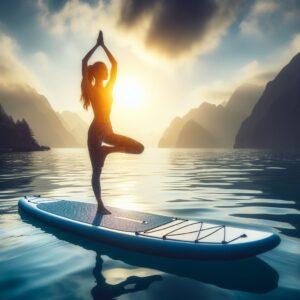 The Tree Pose, also referred to as Vrikshasana, embodies the essence of balance, strength, focus, and harmony in paddle yoga, encouraging individuals to root themselves on the board like a flourishing tree amidst the water’s serenity.
The Tree Pose, also referred to as Vrikshasana, embodies the essence of balance, strength, focus, and harmony in paddle yoga, encouraging individuals to root themselves on the board like a flourishing tree amidst the water’s serenity.
This pose symbolizes the connection with nature as practitioners mimic the stability and grace of a tree swaying gently in the breeze.
By engaging core muscles and finding stability on the paddleboard, one can experience a profound sense of inner balance.
The Tree Pose cultivates mental concentration, requiring focus to maintain the posture on the floating surface, promoting a unified mind-body connection.
This alignment of body and mind leads to a state of inner harmony, mirroring the tranquility found in nature’s peaceful landscapes.
Child’s Pose (Balasana)
 The Child’s Pose, known as Balasana, serves as a restful and calming yoga posture in paddleboard yoga, promoting relaxation, gentle stretching, and a serene connection with the water’s soothing elements.
The Child’s Pose, known as Balasana, serves as a restful and calming yoga posture in paddleboard yoga, promoting relaxation, gentle stretching, and a serene connection with the water’s soothing elements.
It allows for a moment of peacefulness amidst the rhythmic movement of the water below, creating a harmonious balance between body and mind.
By gently stretching the back, hips, and thighs, this pose aids in releasing tension and increasing flexibility.
Going into a state of mindfulness while in Child’s Pose on the paddle board can rejuvenate not just the body but also the spirit, offering a profound sense of tranquility that resonates long after the session ends.
Cobra Pose (Bhujangasana)
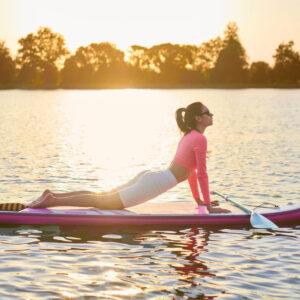 The Cobra Pose, also identified as Bhujangasana, is a dynamic posture in paddle yoga that enhances strength, flexibility, and empowerment, inviting individuals to embrace fluid movements and enhance their physical capabilities on the water.
The Cobra Pose, also identified as Bhujangasana, is a dynamic posture in paddle yoga that enhances strength, flexibility, and empowerment, inviting individuals to embrace fluid movements and enhance their physical capabilities on the water.
This particular pose is especially beneficial for building core strength and improving body alignment as the backbend movement engages the muscles along the spine and abdomen, encouraging stability and balance.
By practicing Cobra Pose regularly on a paddle board, participants can cultivate a sense of empowerment both physically and mentally, as they challenge themselves to find balance and grace amidst the floating surface of the water, fostering a deep connection with nature and their own inner strength.
What Are Some Tips for Doing Yoga on a Paddle Board?
When starting out with yoga practice on a paddle board, it does require certain key tips to ensure a successful and enjoyable experience, such as maintaining balance, focusing on stability, and adapting to the unique dynamics of practicing yoga on water.
It’s crucial to center your awareness on the way the water subtly moves beneath you, letting it enhance your mindfulness and deepening your connection with the surroundings.
As you move through poses, concentrate on your breath to help you remain present and stable. Ensure your body alignment is impeccable, engaging your core for added support and control.
By incorporating these elements into your practice, you can fully immerse yourself in the peaceful harmony of yoga on a paddle board, achieving not just physical strength but also mental tranquility.
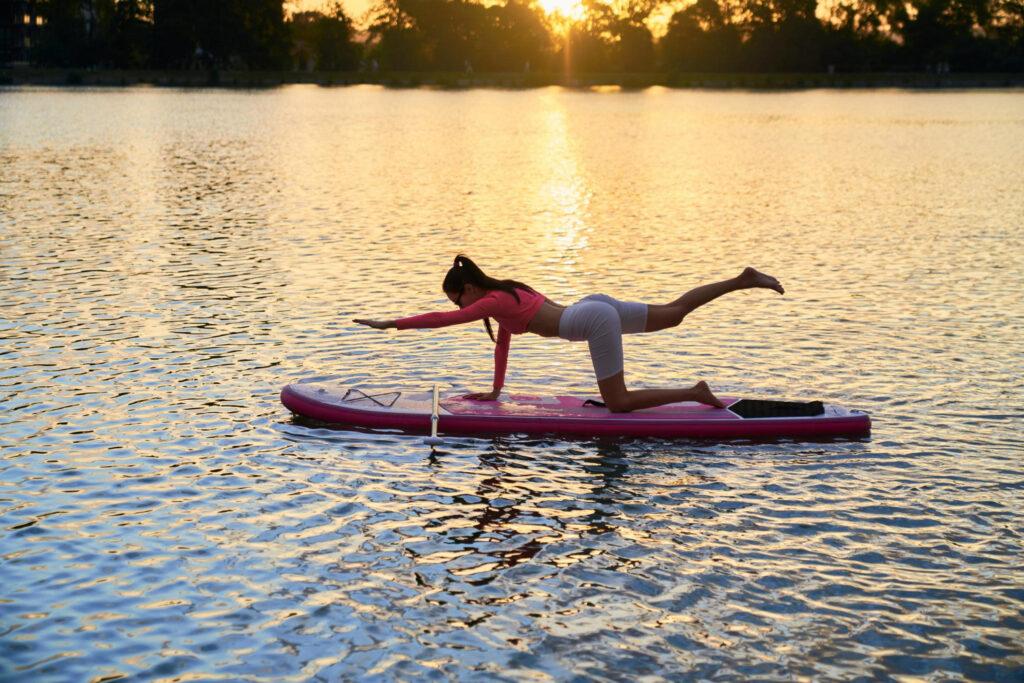
1. Start with a Stable Paddle Board
Initiate your yoga session by ensuring you have a stable paddle board that offers a secure platform for your practice, promoting confidence, safety, and a conducive environment to hone your yoga skills on water.
- Starting with a stable paddle board not only provides a reliable foundation for your yoga routine but also enhances your comfort level during poses. The sturdiness of the board allows you to focus on your breath and alignment, without worrying about instability.
- In addition, practicing on a secure board gives you the freedom to explore more challenging postures with a sense of security, enabling you to advance in your practice. A stable paddle board significantly contributes to your overall aquatic safety, reducing the risk of falls or imbalance while executing different yoga sequences on water.
2. Use a Leash and Anchor
Incorporate a leash and anchor into your paddleboard equipment to enhance safety measures, provide stability, and bolster your confidence during yoga sessions on the water, ensuring a secure and enjoyable practice.
By securing yourself with a leash, you can stay connected to your board even if you fall into the water, preventing the board from drifting away and making it easier for you to rejoin the practice swiftly.
Using an anchor can be a game-changer, offering stability by keeping your board anchored in place, especially in windy or choppy conditions, allowing you to focus solely on your poses without worrying about your board drifting off.
These essential tools not only amplify your security but also prepare you for any unexpected challenges that may arise, boosting your overall confidence on the water.
3. Focus on Your Breath and Balance
Prioritize your breath and balance in yoga as foundational elements that foster mindfulness, strengthen the mind-body connection, and cultivate a sense of serenity amidst the fluid motions of practicing yoga on the water.
By harmonizing your breath with each movement on the paddleboard, you can delve deeper into a state of tranquility, allowing the rhythmic inhales and exhales to guide you through each pose.
Finding stability on the board not only challenges your physical strength but also demands mental focus, honing your ability to remain present in the moment.
This mindful approach to practicing yoga creates a space for introspection and inner peace, where the gentle lapping of the water becomes a soothing backdrop to your peaceful practice.
4. Don’t Be Afraid to Fall
Embrace the possibility of falling during Paddle Board Yoga as a natural part of the learning process, viewing challenges as opportunities to enhance confidence, foster positivity, and overcome obstacles with a resilient and open mindset.
By staying committed to your practice and approaching each stumble as a chance to grow, you not only strengthen your physical balance but also cultivate a mental resilience that can uplift you in various aspects of life.
Every time you find yourself losing balance on the paddleboard, remind yourself that it’s all part of the journey towards self-improvement and mastery. Embracing these moments with a positive attitude can lead to a more profound sense of accomplishment and personal growth.”
What Are Some Safety Precautions for Paddleboard Yoga?
Prioritizing safety precautions in paddleboard yoga is essential to ensure a secure and enjoyable practice that safeguards your health, well-being, and overall experience on the water.
When engaging in Paddle Board Yoga, individuals should always wear a properly fitted life jacket to provide buoyancy and enhance safety in case of any unexpected falls into the water. It is crucial to choose a calm and controlled water environment for your practice, avoiding areas with strong currents or potential hazards.
Regularly checking your equipment, such as the board’s stability and paddle condition, is another vital step to maintain a safe and secure experience.
By being mindful of these safety measures, you can fully enjoy the benefits of Paddle Board Yoga while prioritizing your physical wellness.
1. Wear a Life Jacket
Wearing a life jacket while practicing yoga on your paddle board is a fundamental safety precaution that ensures your protection during water-based adventures, leisure activities, and serene moments on the paddle board.
Having a life jacket on during your paddle yoga session not only offers a sense of security while exploring tranquil waters but also plays a pivotal role in enhancing your overall readiness for aquatic escapades.
The versatility of a life jacket allows you to seamlessly transition from practicing yoga poses on the paddle board to engaging in water sports like kayaking or paddleboarding, all while maintaining a high level of safety awareness.
Whether you are a beginner or a seasoned enthusiast, making a life jacket a non-negotiable part of your gear ensures that you can fully immerse yourself in the exhilarating experiences that water-based activities have to offer.”
2. Don’t Practice in Rough Waters or Strong Winds
Avoid practicing paddle yoga in rough waters or under the influence of strong winds to prioritize safety, maintain stability, and cultivate confidence in your abilities, ensuring a smooth and secure yoga experience on the water.
Being in calm waters not only enhances your sense of security but also allows you to focus on the poses and flow of your movements without unnecessary distractions.
By choosing serene locations for your paddle board yoga sessions, you create a supportive environment that enables you to build your skills gradually, improving your balance and coordination.
The tranquility of calm waters promotes relaxation, helping you let go of any anxieties and fully enjoy the mindfulness aspect of practicing yoga in such a unique setting.
3. Listen to Your Body and Modify Poses as Needed
Practice attentiveness to your body’s signals during yoga and embrace modifications for poses as needed to prioritize your health, empower your practice, and enhance overall wellness through adaptive and mindful movements on the water.
By tuning into how your body responds to each pose, you can make adjustments that suit your unique needs and limitations. This self-awareness not only prevents injuries but also fosters a deeper connection with your physical self.
Remember, self-care is a crucial aspect of any yoga practice, and being attuned to your body’s feedback allows you to practice with intention and mindfulness.
Embracing modifications with a sense of openness and curiosity can lead to a more fulfilling and nourishing experience on the paddleboard, promoting a sense of well-being and self-empowerment.
Final Thoughts and Recommendations
If you enjoy the outdoors and especially being on the lake or the ocean, paddle boarding is truly a great way to enjoy it. If you enjoy yoga and paddle boarding, why not try yoga on a paddle board.
If you would like a paddle board that is great for yoga and to be able to use it on fun water excursions, I highly recommend the Aura Fit by Bluefin. This paddle board is perfect for yoga as it is super stable and easy to control.
The best way to start off doing paddle yoga, is to try the above mentioned poses on dry land if you are new to yoga. Then transition to the board on dryland so that you know what it will feel like when transitioning through the poses. This will give you sense of how the board feels under you.
Once you are confident, go out into shallow waters and progress from there. Just like anything, it takes time to master but once you improve your core balance, you will be an aqua yoga pro in no time.
Get up and SUP!

